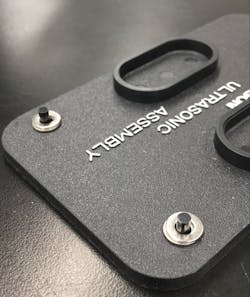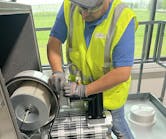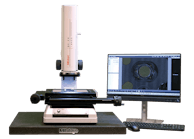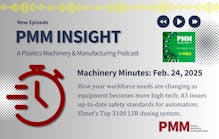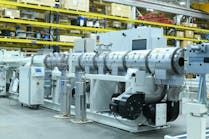Branson's new ultrasonic plastic welding mode adapts to part design and material profile
By Tarick Walton
Global Product Manager – Ultrasonics, Branson Welding and Assembly at Emerson
Traditional ultrasonic plastic welding “modes” utilize computerized measurements associated with each weld. These modes help users manage weld consistency by focusing welder performance around a single parameter or limit that is the most critical to part quality. Typical parameters or limits include downforce, distance/collapse depth, weld time or total weld energy input, which is measured in joules.
Automakers have leveraged steady gains in the consistency of weld controls like these to develop an increasing variety of welded plastic parts in interior, exterior and underhood applications — a boon to decades-long efforts to reduce vehicle weight and improve vehicle fuel efficiency. For typical rigid plastic parts, weld modes like these continue to ensure high repeatability and quality for welding, insertion, staking or swaging applications.
But in the past decade, plastic part designs have evolved in complexity. On one hand, they now involve a wider range of materials, contours and aesthetic requirements. On the other hand, they are called upon to integrate, protect and seal in a greater number of nonplastic components, particularly electronics, switches, sensors and wiring.
Just 10 years ago, the typical car had a relatively small number of sensors, mainly aimed at monitoring the combustion engine and drivetrain components. Today the average number of electronic devices in a car can surpass 200, including processors, sensors, radar and cameras that can augment or replicate certain driving functions. All of these connect the driver, whether human or automated, to information about the vehicle itself or its surroundings, including lane markings, other automobiles, dangerous objects and even people and animals.
Interior lighting is another area of increasing sophistication. From facilitating entry and exit to illuminating maps and instruments, ordinary lighting applications are giving way to mood and even smart lighting — triggered by a pocket fob and the approach of a driver.
Driver-information displays are now a key design element in automobile interiors. From dashboard instruments to interactive maps and satellite radio selections, these displays connect in myriad ways to dozens of electronic elements throughout the car. And, in virtually every case, the plastic housings that protect them require reliable, weather-tight joining, right down to the circuit boards and wiring within the console.
Meeting more complex weld-assembly challenges
Whatever their role within the automotive system, the sophistication and relative fragility of electronic components and sensors housed in, attached to, or protected by plastic structures present challenges for assembly.
To ensure consistent ultrasonically welded assembly of these components, automakers have had to customize their equipment, augmenting single-parameter weld-mode controls with additional information. Generally, this has been done by adding a measuring device — external to the welder — that provides the welder with additional input/output (I/O) – a data point or signal – that is used to adapt the critical weld parameter.
While such customization is not uncommon, it is hardly ideal since it complicates manufacturing engineering, adds to technical support requirements, and increases production costs and complexity. For the ultrasonic welding team at Emerson, it raised questions: “What would it take to build a Branson ultrasonic welder that could eliminate the need for external measuring devices? How could this be done? What kind of new hardware, software or weld modes would it take?”
A group at Emerson sought out the answers. Building on the latest Branson ultrasonic plastic welding platform, the GSX-E1 ultrasonic plastic welder, the team developed a new, patent-pending “dynamic mode,” which is available on the updated Elite Precision+ version of the GSX-E1. The new mode takes advantage of several GSX-E1 features, including its advanced electromechanical weld actuator, new ultrasonic welding algorithms, high-speed data communications and increased computing power. Its upgraded software supports more robust automation and faster actuator response when interfacing with programmable logic controllers (PLCs) and gives users expanded flexibility in developing and deleting application-specific welding recipes.
The welder’s new dynamic mode now enables users to monitor, recalculate and adjust multiple weld parameters in real time (e.g., force, weld energy, velocity, distance) and optimize weld performance within a user-specified target result (e.g., part compression, positioning, pull strength). In essence, the new dynamic mode gives users greater versatility and more consistent results by welding in accordance with the design profile of the part instead of a single parameter.
To use a welder equipped with dynamic mode, the user selects the single-parameter weld mode that is providing the best application results so far. Then, the user enters two application-specific “scores,” which act as limits for dynamic mode activity. The first is a material “density” score that, essentially, characterizes the hardness or resistance of the material that is to receive the welded, staked or inserted part (e.g., a low density score equates to a harder, more resistant material). The second is a weld “reactivity” score, which fine-tunes the reaction time the welder needs to achieve the desired density setting. In operation, dynamic mode monitors each weld cycle, using the density and reactivity limits to adjust and optimize the cycle in response to specific part-to-part variabilities throughout the production run.
“Dynamic mode” ultrasonic welding can outperform single-parameter weld modes when:
· Assembling electronic components sensitive to pressure, vibration or heat damage
· Close tolerance assemblies containing sensitive components require hermetic seals.
· Part structures rely on consistent performance of flexible or elastomeric components.
· Elements must be staked or inserted into substrates that vary in hardness or structural consistency.
Dynamic mode capabilities can be utilized whenever sensitive components, tight tolerances, or complex fit and sealing requirements come into play. For example, consider the need to weld a form-fitting, watertight plastic cover onto the shell of a small electronic device. The cover is closely contoured to fit around sensitive electronic components and complete the device’s protective structural shell. The protective plastic cover must be bonded gap-free and watertight, but the weld process and cover structure cannot be allowed to contact or compress the sensitive electronics directly beneath. Due to ordinary part variability, reliance on a single-parameter weld mode (e.g., weld distance/collapse depth) could exert excessive pressure on the cover and potentially damage internal device electronics.
With the help of material density and reactivity scores, the new dynamic welding mode can optimize distance in each weld cycle. It allows the weld actuator to achieve part collapse depth sufficient for watertight sealing while detecting and avoiding the higher levels of resistance that would occur with compression of the electronic components located immediately below the welded cover.
Dynamic mode is also uniquely capable when it comes to bonding plastic assemblies that contain compressible materials. Consider, for example, an elastomer-filled, two-way pin connector. The outer shell of the connector consists of a molded plastic cup and lid that contain holes through which metal connecting pins protrude. Inside, the pins are embedded in a compressible core of elastomeric plastic, topped by a weld-on lid that compresses the elastomer radially around the pins. Despite the fact that the elastomeric cores vary in height, sealing of the plastic lid requires a flat fit.
The density score used in the new dynamic weld mode allows weld-by-weld adjustment that compensates for the varied consistency and height of each plug’s elastomer core. It ensures not only that the weld actuator travels the required depth but also that it “feels” the specified amount of resistance (e.g., contact with the harder material on the plug’s rim) before making the lid weld.
Conclusion
Manufacturers facing difficult plastic part assembly challenges — miniaturization, closer assembly tolerances, flexible/compressible materials and sensitive electronics content — may well find that advanced ultrasonic welding solutions are now available to meet their requirements. So, instead of thinking about how to redesign a hard-to-assemble part or customize existing welders with external measurement devices, ask your assembly technology supplier for input. Thanks to the exceptional pace of innovation throughout the ultrasonics industry, the solution to your assembly problem may already be available.
ABB appoints chief sales officer for B&R
KraussMaffei now building extruders in U.S.

